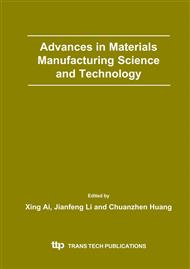p.358
p.362
p.369
p.374
p.380
p.385
p.390
p.396
p.401
Tool Geometry Effect on Machined Surface Integrity in Precision Turning High-Strength Spring Steel
Abstract:
In this paper, Based on regression analysis of tests, three comprehensive experimental models were presented in precision turning high-strength spring steel, Vicker’s hardness, residual stresses and surface roughness can be predicted utilizing these models. And the influence of tool geometry on machined surface integrity was analyzed systematically. The analytical results show that Vicker’s hardness and compressive residual stress will increase with the decrease of rake angle, clearance angle, cutting edge angle or minor cutting edge angle, surface roughness increases with an increase of rake angle or clearance angle and decreases with an increase of cutting edge angle or minor cutting edge angle.
Info:
Periodical:
Pages:
380-384
Citation:
Online since:
December 2004
Authors:
Price:
Сopyright:
© 2004 Trans Tech Publications Ltd. All Rights Reserved
Share:
Citation:


